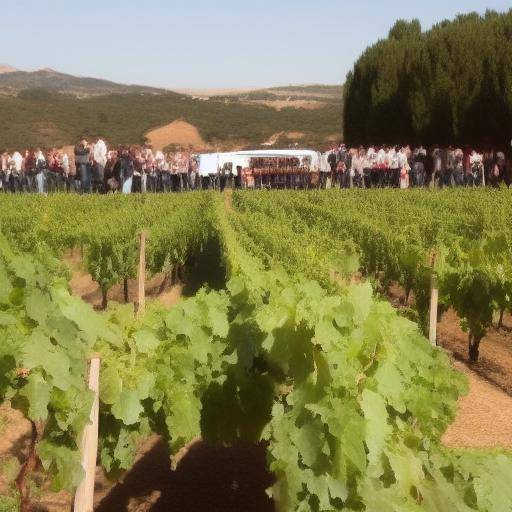
Judaism is a religion rich in traditions and festivals that offer a unique vision of Jewish spiritual culture and practices. Among these festivals, Sukkot stands out as a significant celebration. On this occasion, we will enter the world of Sukkot, exploring its essential components: lulav, etrog and harvest.
Introduction
Sukkot, also known as the Feast of Cabins or Tabernacles, is one of the most important festivities of the Jewish calendar. Although many non-Jewish people have the impression that Rosh Hashanah and Yom Kipur are the only sacred days in Judaism, Sukkot occupies a special place for their deep-rooted beauty, meaning and traditions. In this article, we will explore in depth the importance of Sukkot, focusing on the fundamental components of this festival: lulav, etrog and harvest. We will discover how these elements are intrinsically related to Jewish history, culture and spirituality, offering a deeper understanding of this special celebration.
History and Background
Sukkot has ancestral roots dating back to the Hebrew Bible and is linked to the history of the Jewish people in the desert, as well as to the celebration of the harvest. During this holiday, huts called "sukkot" are temporarily built and inhabited, symbolizing the homes used by the Israelites during their exodus from Egypt. These temporary shelters also represent the fragility of human life and dependence on divine protection.
In addition to the huts, Sukkot is associated with the practice of taking four plant species: lulav (palm), etrog (citric), myrtle branches and willows. These species are agitated together during prayers in each of the seven days of Sukkot, except in the Shabbat.
The festival lasts seven days, during which various ceremonies, rituals and activities reflect the historical and agricultural importance of Sukkot are held.
Analysis in Deep Sukkot
Sukkot represents a moment of joy and gratitude for the harvest, which highlights the intrinsic connection between this holiday and the earth. Through the study of lulav, etrog and harvest in the context of Sukkot, we can appreciate the unique relationship between Judaism, Nature and Spirituality.
The Meaning of the Lulav
The lulav, or palm branch, symbolizes the unity of the Jewish people, as it is composed of three types of branches: palm, myrtle and willow. These branches, which are taken together with the etrog, represent diversity and solidarity within the Jewish community.
The practice of stirring the lulav and etrog during Sukkot is an act of praise and thanks to God for the harvest and fertility of the earth, as well as an expression of unity and connection with the Jewish community throughout the world.
The Spiritual Value of the Etrog
Etrog, a special citric with a particularly distinctive aroma, is considered an exquisite fruit and without defects. This fruit symbolizes beauty and purity, and is associated with virtue and righteousness. During Sukkot, the etrog plays a central role in religious ceremonies, where it is given a remarkable importance.
The act of selecting a perfect etrog and taking it along with the lulav has a profound spiritual meaning. This act represents the search for inner perfection, both personal and community, and reminds us of the importance of integrity and purity in our lives.
The Importance of Harvest
The festival of Sukkot, which occurs after lacosecha, highlights the intrinsic connection between the Jewish people and the earth. The collection of the products of the earth, gratitude for the sustenance and celebration of abundance are fundamental elements of this feast. This agricultural approach underlines the importance of caring for the land and appreciating the fruits it gives us.
Exhaustive examination
Sukkot not only offers a look at Jewish history, spirituality and agriculture, but also reveals timeless lessons and contemporary perspectives that remain relevant today.
Sukkot Benefits and Challenges
The benefits of Sukkot include community development, connection with nature and reminder of the fleetingness of life. However, the challenges may arise by trying to preserve these ancient traditions in a modern and technological world.
Perspective Analysis
The various perspectives on Sukkot offer a broad view of their meaning and importance in contemporary society. From religious perspective to cultural perspective, Sukkot is presented as a festival rich in meaning and relevance.
Comprehensive review
Explore Sukkot's practical applications, including study cases and best practices, allows a deeper understanding of their impact on everyday life and the community.
Comparative analysis
To compare and contrast Sukkot's practices with other cultural festivities and traditions highlights the uniqueness and relevance of these celebrations in the global context.
Tips and Suggested Actions
By offering practical advice and detailed information on Sukkot's practices, this article provides a practical guide for those interested in participating in this celebration.
Conclusions and FAQs
Conclusions
Sukkot, with his emphasis on unity, gratitude and the connection with nature, offers timeless lessons that remain relevant today. By exploring the essential elements of Sukkot, such as lulav, etrog and harvest, we get a deeper understanding of this unique and meaningful holiday.
Frequently asked questions
What is the meaning of stirring the lulav and etrog during Sukkot? The act of stirring the lulav and etrog during Sukkot has a symbolic meaning, representing unity and gratitude for the harvest.
Why are sukkot built during this holiday? The sukkot are built as a reminder of divine protection and the fragility of human life.
Why is etrog considered a special fruit during Sukkot? The etrog is valued for its beauty and purity, symbolizing the search for inner perfection.
What is the importance of the harvest in Sukkot? The celebration of the harvest underlines the connection between the Jewish people and the earth, encouraging gratitude for the fruits it provides.
How is Sukkot celebrated today? Today, Sukkot is celebrated with traditional rituals, such as the agitated lulav and etrog, the construction of sukkot and the singing of special hymns.
What lessons can we learn from Sukkot in modern society? Sukkot offers lessons on gratitude, environmental responsibility and community unity that remain relevant in today's society.
In conclusion, Sukkot is a festival that combines history, spirituality and agricultural traditions to offer a unique and meaningful experience. By exploring its essential components of lulav, etrog and harvest, we can appreciate the cultural and spiritual richness that this celebration brings to Judaism. May this article invite reflection and understanding, allowing deeper appreciation of Sukkot and its importance in Jewish life.
References:
I hope that this article will provide a clear and enriching vision of Sukkot and its fundamental components, as well as a deeper understanding of its importance in Judaism and Jewish culture in general!

